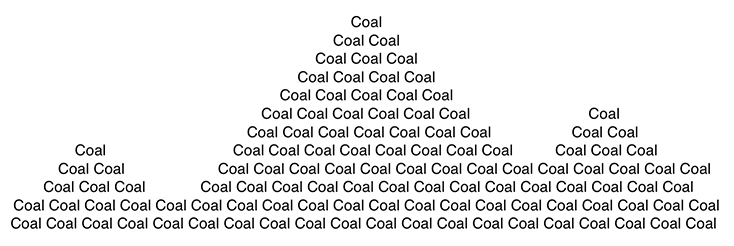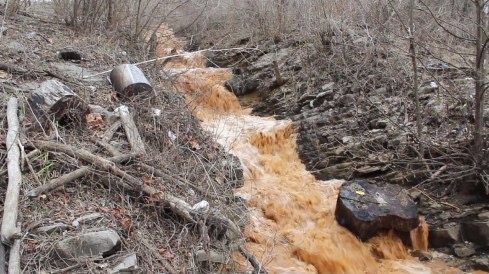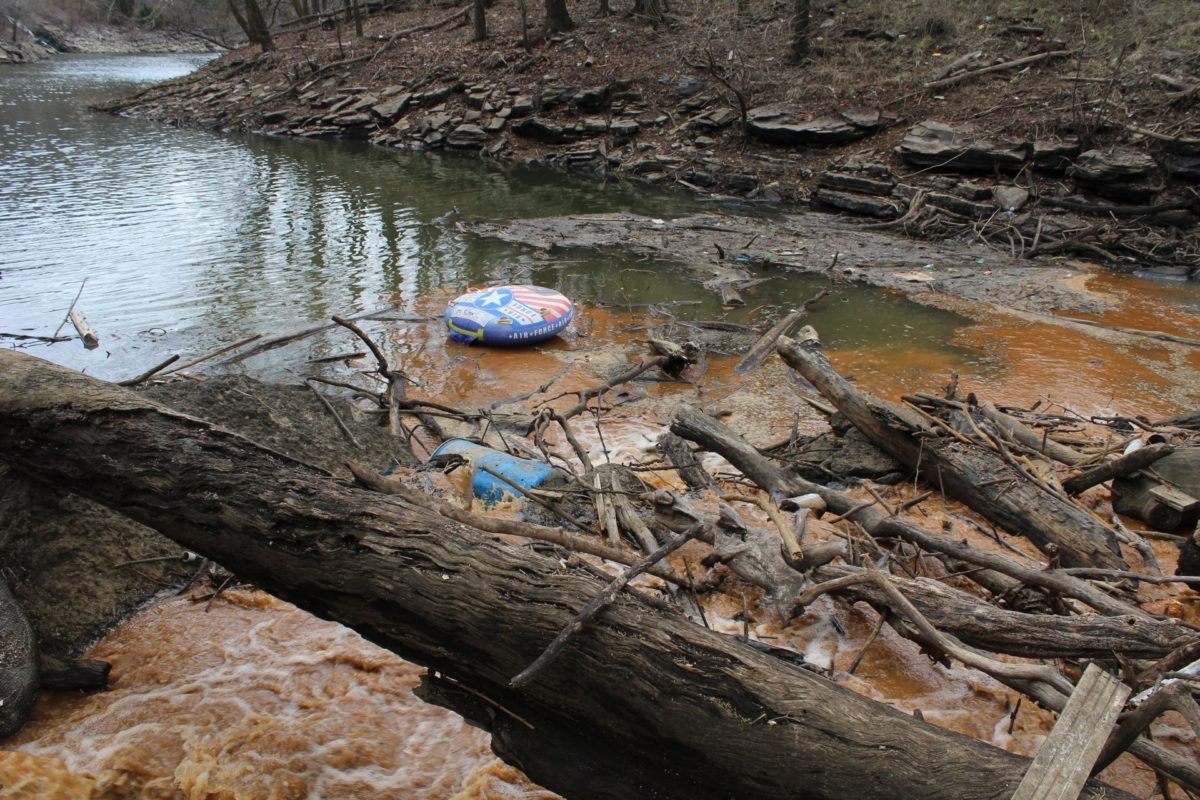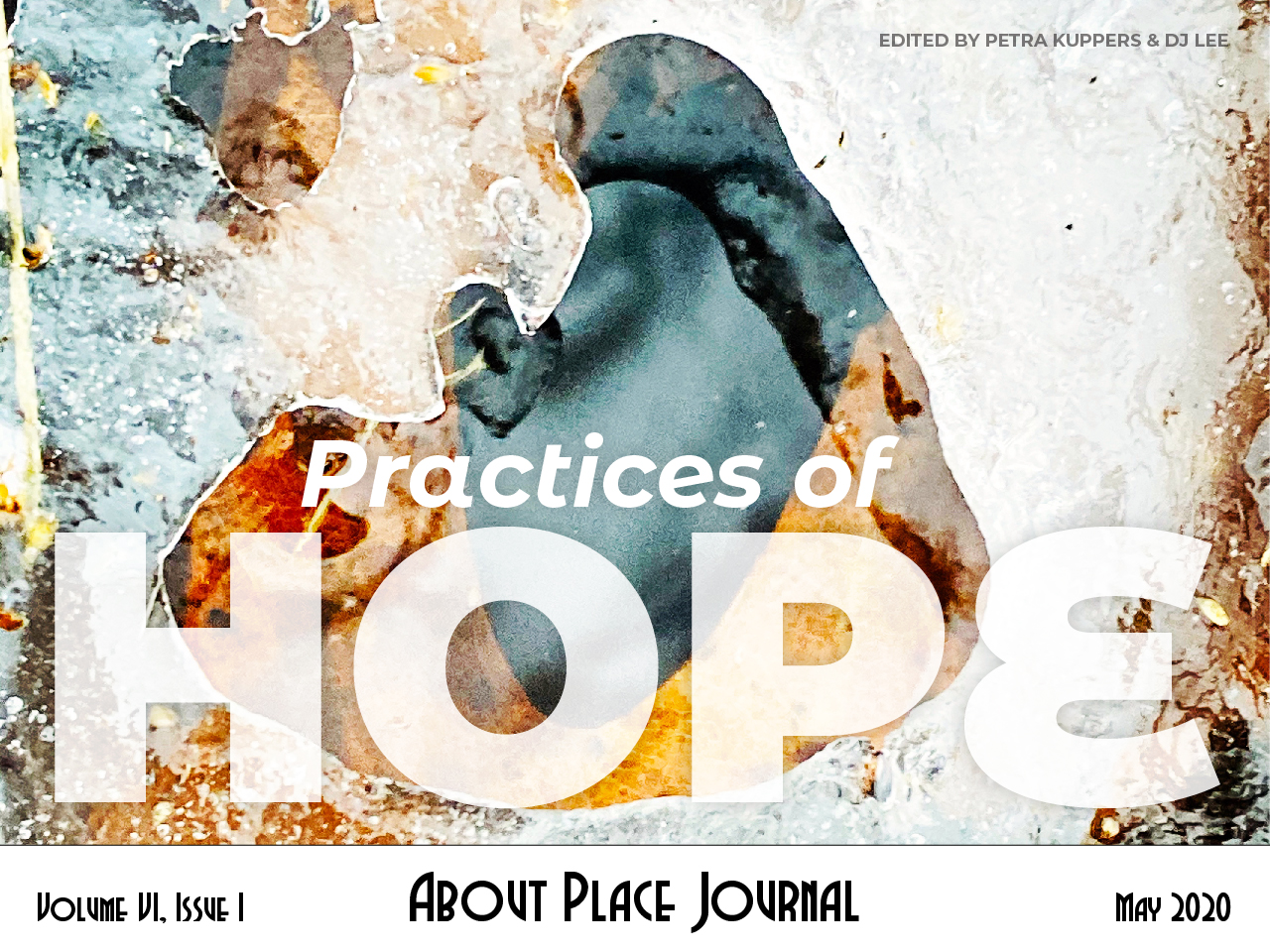I come from coal
My bones are filled with marrow black
liquid carbon fills my veins
the legacy of men whose faces never saw the light of day
whose lungs were filled with pockets filled with dust.
Introduction
“Carbon Glow” is deeply informed by the influence of the coal industry on the state of Kentucky. To “come from coal,” as Maggie Chelland Martin writes in her poem[1], is a “legacy” into which one is born. To be of coal is to be inextricably linked with those “men whose faces never saw the light of day,” whose “lungs” and “pockets” were filled with its dust. While to “come from coal” is traditionally understood as being born into one of those so-called “coal counties” or having a coal miner for “kin,” in a country where vast amounts of corporate wealth are invested in the industry, I suggest that, in many ways, we all “come from coal.”
“Carbon Glow” moves from a traditional focus of a series about coal in Eastern Kentucky to Central Kentucky, where I am from, in an effort to demonstrate the ways in which coal companies and the focus on coal truly dominate and infiltrate every part of the state. I am interested in the ways in which coal influences all parts of Kentucky, not just those considered to be “coal counties.” While originally I intended to focus on these “coal counties,” as others have done, my research rapidly broadened beyond the mine to the cultural, environmental, and social impacts of coal mining.
The structure of “Carbon Glow” is deeply experimental in nature. It is hybrid—ranging from prose poems to photography. As my narrative moves forward in time, I hope to show pockets of resistance to coal’s stranglehold on Kentucky as a state. Primarily, this project does this in a way that is more personal in nature, such as my prose poems that feature my family’s own relationship to the coal industry.
“Carbon Glow,” the second poem in my collection, was inspired by a small, unincorporated community in Letcher County, in Eastern Kentucky. The town was originally founded as a coal camp (taking its name from the coal company that founded it), which speaks to the influence that corporate projects have on the shaping of a town and a region (“Carbon Glow”). It felt very important to me to represent the ways in which people from Appalachia, among them members of my own family, speak and interact. The voice I chose to employ belongs to a former miner who recalled the way in which the community functioned as a coal camp, as well as the town’s decline in the 1950s. Also included in the poem are the names of mining camps and companies in the county, which I used to underscore the influence the industry has even on one small part of the state. Paired with this poem is a photograph of a token from Carbon Glow Mines, Incorporated. Given that miners were obligated to purchase daily necessities at marked-up prices, the company controlled so much of their daily lives, and I really wanted to reflect the sense of desperation miners much have felt in response to this.
A poetic experiment on coal’s impact would not be fully formed without addressing the physical substances that have shaped so much of Kentucky and the region’s cultural and economic life, as my prose poem “Coal” does. In researching the formation of coal, I chose to use sources easily available online and focused towards the general public. One of these resources, the “Kentucky Coal and Education Project” seems specifically created for the purpose of being utilized by teacher in the classroom and ostensibly designed to promote a pro-coal image.
To contrast with this removed and scientific discussion, the first erasure poem in my project engages with the emotional trauma that is by necessity part of the risky endeavor that is mining coal underground in dangerous conditions. This poem, entitled “An Unusual Glow,” is named for a description of a mine explosion in Knott County, Kentucky. Jason Frye’s “Buffalo Creek” in Ghost Fishing affected my choice to address this mining disaster and its influence on individual families. “No Significant Impacts,” the second of these two poems, addresses the pollution of Herrington Lake (a place I grew up visiting and swimming in) with selenium, a byproduct of coal runoff. The original article describes the ways in which the Herrington Lake Conservation League, which is essentially run by executives at Kentucky Utilities, allows the company to disseminate information, such as the results of their so-called “independent” study.
Finally, though I am not by vocation a poet, the very nature of ecopoetry demands an engagement that is both political and personal. While environmental damage is indeed sobering, it is my hope that this project gestures towards the ways in which progress is being made in the region. The final pieces in the collection address both of these aspects. Two photographs depict the pollution in Herrington Lake, and the ways in which the high levels of selenium is made immediately visible via the orange foam collected on and within the water. Notably, other types of pollution are present in one of the images—an abandoned inflatable water toy and an oil drum—speaking to the myriad ways in which environmental damage presents. However, I ultimately hope to present a collection that demonstrates the potential for progress in the region, as illustrated by a prose poem about my father, who once worked for the company responsible for the pollution of Herrington Lake, installing solar panels on the roof of the barn in his backyard. I have always been proud of the ways in which my father has urged the organizations that employed him (the U.S. Air Force and Kentucky Utilities) to adopt more environmentally-friendly practices, and this poem demonstrates his commitment (and the commitment of others in the region) to preserving the natural beauty of my home state. This poem captures for me the hopeful direction in which I hope my project ends—moving from the destruction of coal’s grip on Kentucky and its people to the potentiality of a future in which the environment is honored and respected.
_______
[1] “I Come From Coal”
Arriving at E.W. Brown Power Plant
My mother driving us to visit my father at work always filled me with fear. I hated the power plant. Our first sign of arrival was the smokestacks looming in the distance, belching their smoke into the atmosphere, punctuating the rolling fields of the landscape with their ephemeral exclamations. A stop at the guard shed, and we drove through a winding twisting wooded road before we reached it. The damn dam, where tiny metal bumpers were all that stood between my mother’s car and
Carbon Glow

Coal[2]
_______
[2] Scientific information for this piece came from Kentucky Coal Education and Online Kentucky Coal Facts. The former is “hosted and designed by Mining Internet Services, Inc.”
An Unusual Glow[3]
TOPMOST — One night in November 1981, Roy Conley saw an unusual glow around the electrical center at the small underground coal mine in Knott County where he worked, and he took it as a divine warning.
Conley kept it to himself for three weeks, but the worry was making him ill. He broke into tears when he finally told his wife: “I feel in my heart I’m going to get killed.”
He skipped the next work day at the Adkins Coal Co. mine at Topmost.
But with young children to feed and bills to pay, he went back on Dec. 7, 1981 — the day the mine blew up, killing eight men less than an hour into their shift.
It was the worst mine disaster in the county’s history.
•••
One of Knott County’s favorite sons, Democratic U.S. Rep. Carl D. Perkins, once said there was a prevalent, fatalistic attitude when he got to Congress in January 1949 that “some people are just bound to get killed” mining coal.
•••
There were 10 employees at the mine when the second shift started at 2 p.m. on Dec. 7, 1981.
Nine toiled underground, often on their knees because the coal seam in the mine was only about 31 inches high, and one worked at the repair shop outside.
The mine used a method called “shooting from the solid” to blast coal loose. Employees drilled a series of holes into a wall of coal, then tamped in a nitroglycerin-based explosive and detonated the charges.
The blasting caps in each hole had different delay periods, so the charges went off in sequence across the working face — something like slicing off pieces of bread from a loaf. Miners used a machine called a scoop to gather the loose coal and dump it on a conveyor system.
Some states had banned shooting from the solid because of concerns that it was dangerous, but it was common at hundreds of small mines in Eastern Kentucky at the time.
•••
Nearly half a mile away underground, the blasting powder in one hole had failed to detonate. That created extra pressure on the next charge, and flame shot out from that hole into the mine, like a backfire. The flame ignited fine particles of coal dust and the explosion propagated, sucking in more coal dust to feed on as it tore through the mine.
It would have been like a tornado on fire, said Ray Slone, a longtime miner and the brother of David Slone, one of the men at the Potato Branch mine.
Debris from the explosion, which happened at 2:50 p.m., smashed glass in vehicles outside the mine. Conley said the shock wave lifted him off the ground.
Conley was dazed. He remembers staring briefly at his hand, which he had raised toward the mouth of the mine, and thinking that if his hand was real, if he could see it, then the blast was real as well.
He tried to call Dillard Ashley, whose work station was close to a phone in the mine, but he got no answer.
“I was scared to death,” he said.
•••
Willard Stanley, the state mines commissioner, trudged into the school late in the evening to announce to the anxious families that several bodies had been found.
“Their reaction was just panic, screaming and crying, grabbing each other, holding on to each other,” said the Rev. Charles Wilcox, a hospital chaplain who was there to help families.
In addition to David Slone, those who died were Dillard Ashley, 40; James Gibson, 24; Tommy Centers, 31; the easy-going foreman, Bob Slone, 39; Clarence Perry, 28; his brother Roy, 22; and Keith Crager, 25. All eight died from inhaling deadly carbon monoxide, according to a federal report.
Crews took the bodies to a rescue-squad building nearby and asked relatives to identify them. Bob Slone’s daughter Josephine, then 17, said she did the grim job because her mother was pregnant with the couple’s 11th child, three of whom had died.
When an ambulance worker unzipped the body bag, her father’s arm fell out. She recognized his wristwatch, then saw her father’s blackened face and singed hair.
•••
“Just think how many lives was destroyed that day.”
_______
[3] From an article originally published in the Lexington Herald-Leader, entitled, “Hundreds died in Kentucky coal mines in decades after mine blast exposed safety problems”
What Kentucky Mountains Look Like, to a Mining Company

What Kentucky Mountains Mean, to a Mining Company

No Significant Impacts[4]
Coal ash pollution confirmed in Herrington Lake, but study finds ‘no significant impacts’
Conditions in Herrington Lake “do not pose an unacceptable risk to human health,” according to a study completed last month, paid for by Kentucky Utilities. But the study does list several ecological effects on the lake from selenium, found in coal ash runoff, which it says “should be monitored,” among other issues.
KU submitted a 552-page assessment, referred to as “an independent study,” to the Kentucky Energy and Environmental Cabinet for its review and approval. The study began in 2017 and was conducted by Ramboll, an international environmental consulting group, which KU hired.
It’s all part of a corrective action plan (CAP) between the state Energy Cabinet and KU, created after pollution was found near the utility company’s Mercer County power plant, E.W. Brown Generating Station. The plan was required after a follow-up inspection of the area after the utilities had been hit with a state fine, about five years ago.
The state’s water testing found selenium levels in fish at 98 times the legally allowed limit near the plant, which is close to Dix Dam. Area groups upset about the issue circulated photos taken of a near-by inlet, showing discolored runoff water running into the lake.
KU began efforts to close its existing ash ponds at the plant, as well as to construct new treatment facilities for coal combustion materials and “an environmentally protective landfill.” KU says it has spent more than $100 million on these changes already.
However, those improvements are a result of the Environmental Protection Agency’s “more stringent … standards,” as stated by KU on its website, referring to requirements through the Safe Drinking Water Act.
•••
Groups are worried about the existing pollution in the lake they say has already been well-studied and documented, and are suing KU in hopes of getting a clean-up commitment. Some of those documents are currently the focus of a second lawsuit, this time against the state cabinet for withholding public records concerning its study without a legal reason.
On June 28, the Herrington Lake Conservation League circulated an email to its members and The Advocate-Messenger, announcing the results of the study KU commissioned.
“KU’s pleased to let our Conservation League members know that the lengthy and in-depth independent study indicates its operations at E.W. Brown have had no significant impacts on the water quality or fish populations in Herrington Lake,” the release states.
The conservation league is an all-volunteer, non-profit corporation “created to restore the natural beauty and improve the environmental health of Herrington Lake,” as stated on its website.
•••
“For the sake of transparency, I am a KU employee,” says Angela Zevely. She’s the environmental supervisor at E.W. Brown, who is also president of the conservation league.
•••
Locke[5] says the report states the same thing now as Earthjustice did when it filed its lawsuit. “Data confirmed there’s a significant contamination problem in the inlets near the site — elevated levels of coal ash contamination in the water, sediments, fish — it’s all documented in the report.”
It also confirms the pollution is coming from contaminated ground water leaking from the power plant’s coal ash ponds. “So, essentially, KU’s study took two years to confirm what we already knew to be true,” Locke says.
Earthjustice and others concerned want KU to undertake a meaningful clean-up, and stop the ongoing flow that’s still coming from the impoundments, Locke says.
“Those contaminants are embedded in the sediment of the lake right now. A reserve of contaminants, sitting there, making their way into the food chain,” Locke says, and references the pop-eye condition and spine deformities of fish found in an earlier study.
As far as exactly what it would take to correct the entire issue, sediment and all, most have only responded it would be extremely costly.
“What would it take? That is one of the questions worth exploring,” Locke says. “(KU) could’ve been looking into that while they were fighting the responsibility.”
•••
KU was asked for its response to the findings. “It was an independent study that was done,” said Lizz Pratt, KU media relations manager. She said it was submitted to the cabinet.
“We did take a look at it.”
Pratt said the company has been circulating the fact the study is now complete — and posted in its entirety on KU’s website — to area groups and residents.
When asked about the concentrations of selenium and other pollutants in the area of the inlet, Pratt said, “I want to make clear — the findings of the study did confirm the water quality meets water quality standards,” and that there is no recreational danger to using the lake.
•••
The email goes on to say, “While the study notes the presence of arsenic and selenium in the sediment, it also cites data, which is included in the report, from the U.S. Geological Survey that identifies some of the highest levels of these naturally-occurring metals are found in Central Kentucky soil.
“Just to point out again, the results of this independent study indicate our plant operations have had no significant impacts on the water quality or fish populations in the lake, and its findings confirm the water quality is safe for recreational use and meets safe drinking water standards for our community.”


_______
[4] From an article originally published in the Danville Advocate-Messenger, entitled, “Coal ash pollution confirmed in Herrington Lake, but study finds ‘no significant impacts.’”
[5] “Attorney Ben Locke with Earthjustice, one of the organizations currently suing over lake pollution.”
Solar Panels


